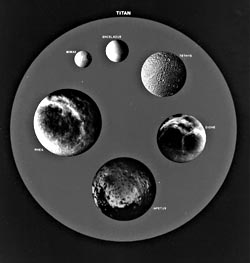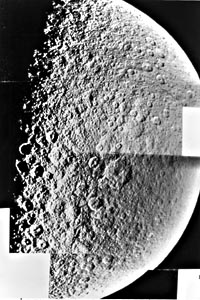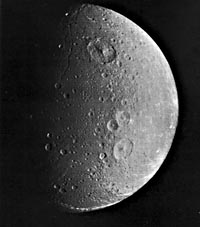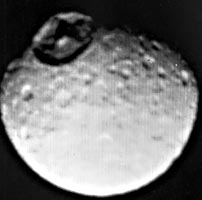 |
|---|
| Plate P-14 |
 |
|---|
| Plate P-14 |
The satellites of Saturn (except for Titan) can be called ice worlds. Their low densities and reflection spectra indicate that they are not only coated with water ice but must also be largely ice or water all the way through (probably mixed with dispersed silicates and perhaps ammonia in some). This bulk composition, although strange by terrestrial standards, is understandable in view of Saturn's great distance from the Sun. There is a striking compositional gradient in the solar system as a whole, from iron/silicate planets near the Sun to volatile-rich bodies farther out that consist mainly of hydrogen (the giant planets) or hydrogen compounds (the icy satellites, comets, and perhaps some asteroids). Unlike the Jovian system, the satellites of Saturn exhibit no obvious compositional gradient comparable to that from Io to Callisto, suggesting that the proto-Saturn was cooler than proto-Jupiter.
Geomorphically, the small Saturnian satellites provide examples of landforms produced on planets composed essentially of ice (Morrison, 1982). The term "ice" applies in a general sense inasmuch as the material making up the Saturnian satellites is probably not pure H20, but may include H2O-NH3 eutectics and, in deep interiors, high pressure H2O polymorphs. Furthermore, the temperatures in Saturnian satellites may be far below those usually prevalent in terrestrial glaciers, and the physical properties may therefore be unfamiliar by terrestrial standards (Veverka, 1985).
| Figure P-14.1 | Figure P-14.2 |
|---|---|
 |
 |
Six of the medium-sized satellites of Saturn shown in the Plate (Meszaros, 1983) are superimposed on a disk representing the comparative size of Titan (5150-km diameter), the largest moon in the solar system. (Titan´s surface is obscured by a thick opaque atmosphere.) The ice satellites exhibit a series of terrains ranging from highly cratered primitive terrains to those showing a considerable degree of resurfacing. The largest of these satellites, Rhea, is also the most heavily cratered (Figure P-14.1), as shown in this Voyager 1 view of the north polar region. However, the distribution of craters in this area is definitely nonuniform, with a much higher density of fresh-looking craters in the lower left part of the image (Smith et al., 1981). Smith et al. labeled the craters of the heavily cratered area Population I, formed by impacts in the early post-accretion period, and those of the other area Population II. They considered the different populations to result from different ages rather than differing impact rates, with a period of resurfacing that mantled the older craters at the upper right of the Plate (part of low albedo area).
The most clearly visible craters differ from those seen on Ganymede in that they show little evidence of flattening by ice flowage and are notably irregular or polygonal. This may indicate that the crust of Rhea became cold and solid early in its history. Distinct ejecta blankets around the craters are generally rare, owing to the lower gravity of Rhea, which permits ejecta to spread much farther than on the Moon, forming thinner ejecta blankets.
Dione has a markedly different topography (Figure P-14.2), including both impact and tectonic features. Three distinctly different types of terrain are visible here (Moore, 1984): heavily cratered terrain (right), cratered plains (left center), and smooth plains (upper left). The heavily cratered terrain is presumably the oldest, having been covered by internally expelled material to form the plains. Although the nature of the plains-forming material is unknown, it may have been erupted as a liquid, pyroclastic, or snow-like material. The term "volcanism" is generally applied to this resurfacing process, a curious term for a satellite whose surface temperature is now less than 100°K. However, the lava or ash analog was probably not a hot silicate liquid but water, ammonia, or organic compounds, with a significant fraction of rocky or carbonaceous material, as proposed by Plescia (1983).
| Figure P-14.3 | Figure P-14.4 |
|---|---|
 |
 |
The craters on Dione, almost certainly formed by impact during the post-accretionary period after the plains-forming events, resemble those on the terrestrial planets in that they have central peaks and raised rims. However, they are relatively shallow compared to similar-sized craters on silicate bodies, suggesting that viscous flow of the ice crust has flattened their initial forms.
The smooth high-albedo surface of a smaller Saturnian moon, Enceladus (Figure P-14.3), shows even stronger evidence of tectonic and volcanic activity. The resurfacing process inferred for Rhea and Dione went further here, producing substantial areas with no impact craters visible at a resolution of 2 km/line pair. This curious situation, reminiscent of Io, clearly implies relatively recent eruption of whatever the resurfacing material is, perhaps an ammonia/water mixture. Smith et al. (1981) estimated that such surfaces could not be over 1 billion years old, far from primordial. Squyres et al. (1983) suggest that tidal dissipation may, as in Io, have repeatedly melted the interior of Enceladus up to the present, augmented by radioactivity. They further suggest that the grooves may be extension fractures.
The dominant landform on Mimas is obviously the huge impact crater, Herschel (Figure P-14.4), whose size (130 km) approaches the diameter of the satellite (400 km). The presumed impact must have almost broken up the entire satellite. Mimas is also noted for the very high density of impact craters and, of all the Saturnian satellites, comes closest to representing a primordial crater-saturated terrain. The craters tend to be relatively deep, implying less viscous flow. 83-H-223.
Continue to Plate P-15| Chapter 10 Table of Contents.| Return to Home Page| Complete Table of Contents|